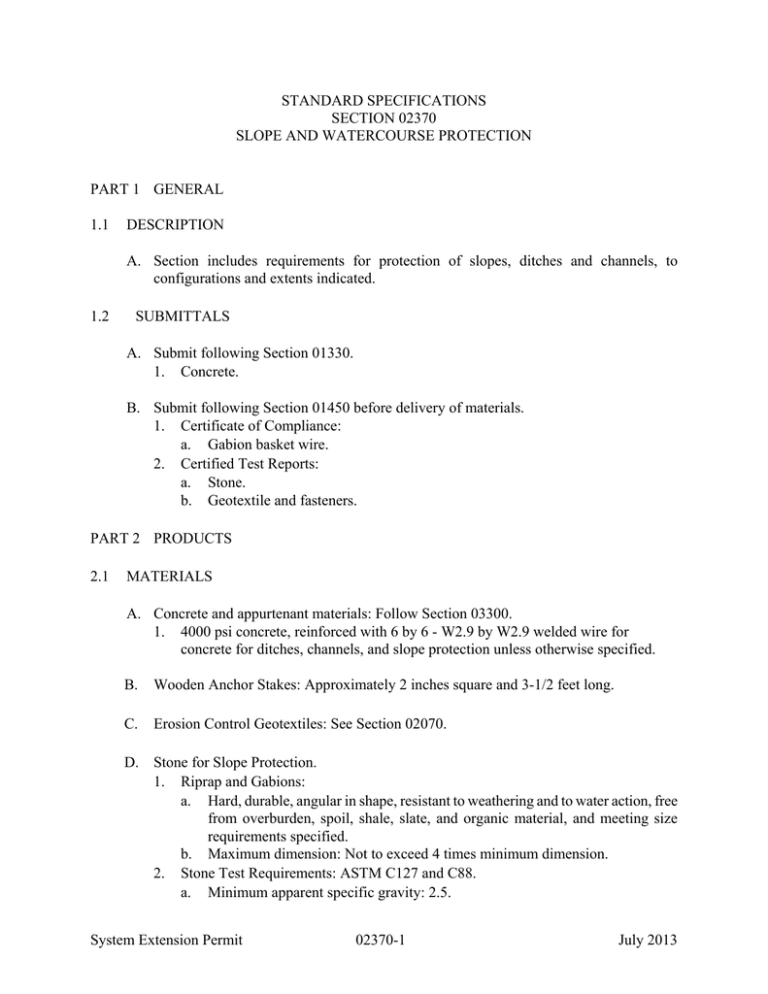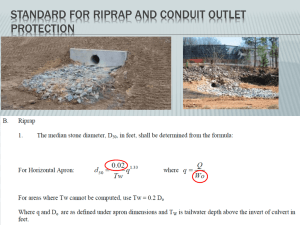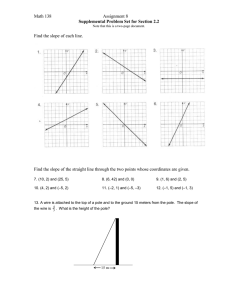02370 Slope and Watercourse Protection
advertisement

STANDARD SPECIFICATIONS SECTION 02370 SLOPE AND WATERCOURSE PROTECTION PART 1 GENERAL 1.1 DESCRIPTION A. Section includes requirements for protection of slopes, ditches and channels, to configurations and extents indicated. 1.2 SUBMITTALS A. Submit following Section 01330. 1. Concrete. B. Submit following Section 01450 before delivery of materials. 1. Certificate of Compliance: a. Gabion basket wire. 2. Certified Test Reports: a. Stone. b. Geotextile and fasteners. PART 2 PRODUCTS 2.1 MATERIALS A. Concrete and appurtenant materials: Follow Section 03300. 1. 4000 psi concrete, reinforced with 6 by 6 - W2.9 by W2.9 welded wire for concrete for ditches, channels, and slope protection unless otherwise specified. B. Wooden Anchor Stakes: Approximately 2 inches square and 3-1/2 feet long. C. Erosion Control Geotextiles: See Section 02070. D. Stone for Slope Protection. 1. Riprap and Gabions: a. Hard, durable, angular in shape, resistant to weathering and to water action, free from overburden, spoil, shale, slate, and organic material, and meeting size requirements specified. b. Maximum dimension: Not to exceed 4 times minimum dimension. 2. Stone Test Requirements: ASTM C127 and C88. a. Minimum apparent specific gravity: 2.5. System Extension Permit 02370-1 July 2013 3. b. Maximum absorption: 3.0 percent. c. Sodium sulfate soundness: Five cycles in 2-1/2 - 1-1/2-inch aggregate. d. Maximum loss for class 1 through 3 stone: 20 percent. e. Maximum loss all others: 12 percent. Use riprap reasonably well graded from smallest to largest weight specified. Stone weight for riprap will be controlled by visual inspection. CLASS 0 1 2 3 WEIGHT Heavier than 33 lb. Heavier than 10 lb. Less than 1 lb. Heavier than 150 lb. Heavier than 40 lb. Less than 2 lb. Heavier than 700 lb. Heavier than 200 lb. Less than 20 lb. Heavier than 2000 lb. Heavier than 600 lb. Less than 40 lb. ALLOWABLE PERCENTAGE 0 50* 10 max 0 50* 10 max 0 50* 10 max 0 50* 10 max *Note: Optimum gradation is 50 percent of stone being above and 50 percent below midsize. Reasonable visual tolerances will apply. 4. Stone sizes for gabions will be controlled by visual inspection. Basket Thickness in Inches 6 9 12 18 24 36 5. Size of Individual Stones in Inches 3-5 4-7 4-7 4-7 4-12 4-12 Surge Stone: 3 inches to 7 inches. E. Stone for Stream Invert Protection: Armor stone meeting above requirements for Stone for Slope Protection: Riprap and Gabions, and Stone Test Requirements, except as shown on Drawings. F. Filter Material: 1. Sand, Gravel, or Crushed Rock: a. Follow gradation shown on Drawings and Section 02315. System Extension Permit 02370-2 July 2013 Composition: Tough durable particles, reasonably free of thin, flat, and elongated pieces, and containing no organic materials nor soft friable particles. Erosion control geotextile, type B, when applicable or specifically required. b. 2. G. Wire Baskets for Gabions: Compartmented rectangular containers of galvanized steel hexagonal wire mesh, with or without additional protective coatings, and filled with stone for slope. 1. Dimensions: Subject to tolerance of 3 percent, more or less of manufacturer's stated size. a. Gabions 6 and 9 inches thick. 1) Length in multiples of individual compartments: 3 feet. 2) Width, minimum: 6 feet. 3) Wire mesh woven into triple twisted hexagonal openings 2.25 inches by 3 inches with tolerance of 0.25 inch. 4) PVC coating not required. b. Gabions 12, 18, 24, and 36 inches thick. 1) Length in multiples of individual compartments: 3 feet. 2) Width minimum: 3 feet. 3) Wire mesh: Woven into triple twisted hexagonal openings 3 inches by 4.25 inches with tolerance of 0.25 inch. 4) PVC coating required. 2. Basket Compartments: a. Subdivided into compartments of required minimum length extending over full width of basket by inserting partition of same mesh as basket. b. Secured partitions in proper position to base and sides. 3. Fabrication: a. Base sides and lids: Assemble at construction site into rectangular unit of specified size. b. Base, lids, ends, and sides: Either woven into single unit or at least one edge of these members is connected to base of unit so that strength and flexibility at point of connection is at least equal to that of mesh. c. Perimeter edges of mesh forming basket unit: Securely selvaged or bound so that joints formed by tying selvages have at least same strength as body of mesh. d. Prefabricated wire ties or connecting wire: 1) Supplied in sufficient quantity to securely fasten edges of basket and partitions. 2) Meeting or exceeding specifications for wire used in mesh, except that diameter of core: U.S. Steel Wire size No. W0.5, (0.080 inch, plus or minus 0.003) minimum for channel protection baskets. 4. Wire and Wire Mesh: Galvanized coated steel wire with minimum diameter core U.S. Steel Wire, size No. W0.5, (0.080 inch, plus or minus 0.003) for slope mats and No. W1.0 (0.113 inch, plus or minus 0.003) for channel mats. a. Tensile strength: 60,000 to 85,000 psi following ASTM A392 and ASTM A370. System Extension Permit 02370-3 July 2013 b. c. d. e. f. Elongation: Sufficient elasticity to permit elongation of mesh equivalent to minimum of 10 percent of length of mesh section under test without reducing gauge or tensile strength of individual wires to values less than those for similar wire 1 gauge smaller in diameter. Elasticity: After elongation test. 1) Use uncut section of mesh, 6 feet long and not less than 3 feet wide including selvage bindings, with ends securely clamped for 3 feet along width of sample. 2) When width of sample under test exceeds 3 feet, place clamps in middle portion of width with excess width falling free on each side of clamped section. 3) Subject sample to sufficient tension to cause 10 percent elongation of sample section between clamps. 4) While clamped and otherwise unsupported, apply 6000 pound load to area of 1 square foot located approximately in center of sample section between clamps, and in direction perpendicular to direction of tension force. a) Withstand without rupture of wire, or opening of any mesh fastening, actual load, so applied, equaling or exceeding 6,000 pounds. 5) Ram head used in test: Circular with its edges beveled or rounded to prevent cutting of wires. Single strand cut: Wire mesh fabricated so it is non-raveling, defined as ability to resist pulling apart at twists or connections forming mesh, when single wire in section of mesh is cut and section of mesh is subjected to load test described in elasticity test above. Zinc coating: 1) Hot dipped galvanized following ASTM A123 2) Minimum 0.80 ounces per square foot following ASTM A90 PVC coating: 1) Where indicated, use galvanized steel wire coated with minimum of 0.4 mm (0.0157 inches) of PVC to: a) Resist destructive effects of immersion in acidic salt, or b) Prolonged exposure to ultraviolet light and abrasion, and c) Retain these characteristics after period of not less than 3,000 hours under test following ASTM G152 and G153. 2) Color: Gray or other neutral color approved by Contract Manager. PART 3 EXECUTION 3.1 CONCRETE CHANNELS AND DITCHES A. Construction: Follow Section 03300 and modified herein. 1. Grade, trim, tamp, and prepare surface to receive concrete to elevations required by Drawings. System Extension Permit 02370-4 July 2013 2. B. 3.2 Protect Work that will be exposed to temperatures of 40 degrees F. or lower minimum of 4 days after placing by covering with 1 foot of straw, hay, or mulch and covering with securely anchored canvas. Placement: Follow details and limits shown on Drawings and specified herein. 1. Joints: As shown, in true alignment. 2. Finish edges and joints with approved edging tool with 1/4 to 1/2 inch radius. 3. Insert 1/2 inch expansion joint material and sealer at expansion joints and where concrete abuts existing and other materials. 4. Screed top surfaces with wooden screed and finish with wood float. STREAM INVERT PROTECTION A. Provide armor stone stream invert protection following Drawings and Section 01570. 3.3 UNGROUTED RIPRAP A. Place Riprap following Section 02070 and specified herein. B. Class 1 Riprap Stone (Placed Riprap). 1. Preparation: a. Remove unsuitable material and replace with suitable material following Section 02315, when directed by Contract Manager. b. Excavate trench along toe of slope where indicated on Drawings. 2. Placement: Begin with toe. a. Place larger stones, as specified by design gradation, in toe and along perimeter of slope and channel protection. b. Place riprap with suitable equipment to produce a reasonably graded mass of stones with zero drop height. c. Placing stones that cause extensive segregation is not allowed. d. Where appropriate construct a low flow channel through riprap. C. Class 2 Riprap Stone (Placed or Dumped Riprap). 1. Preparation: a. Remove unsuitable material and replace with suitable material following Section 02315, when directed by Contract Manager. b. Excavate trench along toe of slope as shown for placed riprap. 2. Placement: In trench with larger rocks and on outside surface of slope protection. a. Place rocks to minimize voids. b. Rock may be placed by dumping as specified herein and may then be spread in layers by bulldozers or other suitable equipment. c. Do not vary local surface irregularities of slope protection from planned slope by more than 1 foot measured at right angles to slope. System Extension Permit 02370-5 July 2013 D. Class 3 Riprap (Dumped Riprap). 1. Preparation: a. Remove unsuitable material and replace with suitable material following Section 02315, when directed by Contract Manager. b. Excavate trench along toe of slope where indicated and rough grade to limits indicated on Drawings. 2. Placement: On subgrade or gravel filter material to its specified thickness and to extent shown on Standard Details. a. Place in 1 operation so as not to disturb underlying material. b. Do not place in layers and dump into chutes. c. Distribute and compact larger stones well. 1) Manually place or rearrange individual stones by mechanical equipment to secure required results. 2) Do not vary local surface irregularities from planned slope by more than 1 foot measured at right angles to slope. d. Where riprap and filter materials are dumped under water, increase thickness of layers following Drawings and employ methods that minimize segregation. E. Imbricated Rip Rap. 1. Preparation: a. Remove unsuitable material and replace with suitable material following Section 02315, when directed by Engineer. b. Excavate loose material at toe of embankment until stable foundation is reached, usually within 2-3 feet of surface. c. Subgrade should be smooth, firm and free from protruding objects or voids for proper positioning of the first layer of stones. 2. Placement: On graded granular filter or geotextile as shown on Standard Detail. a. If geotextile is used place carefully and loosely on prepared slope and secure. 1) Overlap adjacent strips minimum 8 inches. 2) If geotextile is torn or damaged, repair or replace. b. Stack rock layers with staggered joints so each stone rests firmly on two stones in the tier below. Use smaller stones to fill voids. c. Upon completion of first layer, fill toe trench with Class III rip rap. 1) Use two footer stones where high potential for channel incision exists. d. Height of imbricated revetment is dictated by size of stone used. 1) Height: Not exceed 3 times length of longest axis and not greater than 10 feet. e. Place granular backfill concurrently with stone placement. Backfill slope angle should be 2H:1V or flatter, but greater than 0 degrees. 3. After backfill is in place, cover with geotextile and layer topsoil sufficient to support native vegetation cover. F. Place ungrouted riprap at stream crossing as specified herein and to limits noted on Standard Detail. System Extension Permit 02370-6 July 2013 3.4 GABIONS A. Stone Filled Gabion Slope Protection. 1. Preparation: a. Forms slopes and other areas as shown on Drawings. b. Remove unsuitable material and replace with suitable material following Section 02315, when directed by Contract Manager. c. Cover compacted subgrade with erosion control geotextile. d. Cut holes size of wooden anchor stakes through geotextile and drive wooden anchor stakes to anchor gabion units in place. 2. Placement. a. Assemble each gabion unit by binding together vertical edges with wire ties on approximately 3 inch spacing or by continuous piece of connection wire looped around vertical edges with coil approximately every 3 inches. b. Place first unit of gabion at bottom of slope and work upward. c. Set empty units to line and grades indicated on Drawings. d. Secure units together in same manner as described for assembling. e. After setting gabions to line and grade, stretch to remove any kinks from mesh and to hold alignment, using standard fence stretcher, chain fall, or iron rods. 3. Units: Fill with stone placed by hand or machine, to produce minimum of voids between stones and avoid bulging of mesh. a. Do not drop stone from height of more than 3 feet into units. b. Place minimum of 2 courses of stone. c. After filling gabion unit, bend lid over until it meets ends of unit. d. Secure lid to sides and ends with wire ties or connecting wires in manner described previously for assembling. e. Cut gabion units to fit when directed by Contract Manager. 3.5 SODDED DITCHES A. Sodded Ditches: Follow Section 02920. 3.6 MAINTENANCE A. Maintain slope protection until completion of Project and repair damage from any cause or replace before completion. **WSSC** System Extension Permit 02370-7 July 2013


